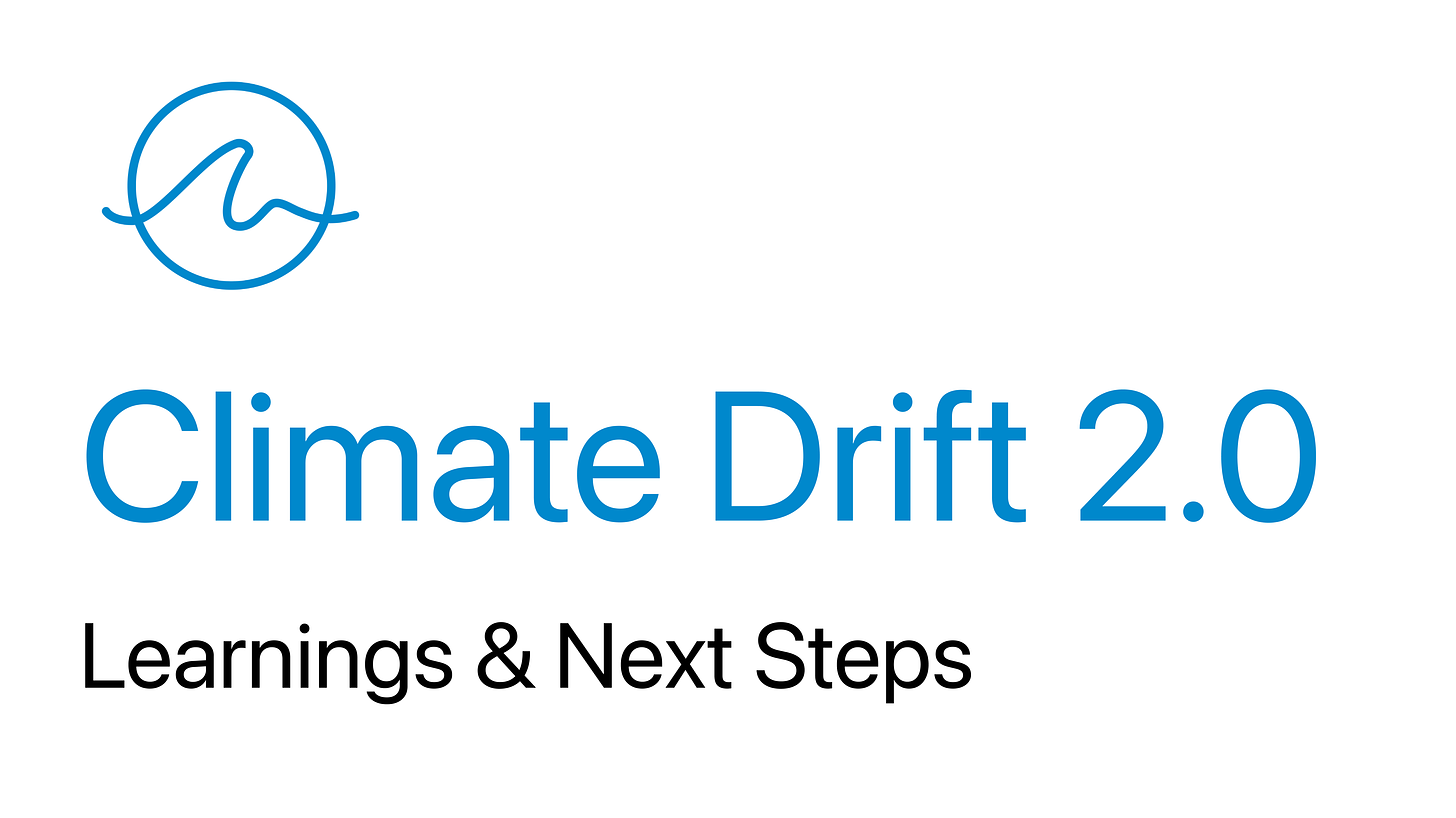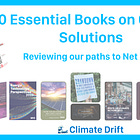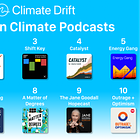🚀 If you want to make a difference and bring your talent into climate:
Apply to our next cohort and join the Climate Drift Accelerator.
Interviews and admissions are happening right now.
Hi there! 👋
Skander here.
We spend a lot of time thinking about how to get more people into climate.
We also spend a lot of time doing it:
1-1 calls with career transitioners
Working with climate investors & climate companies
Writing and sharing deep dives into climate solutions
Over the last year we poured every hypothesis & solution into a program.
Now we wanted to share the first learnings and our next steps.
Today we are covering:
❓ The problem
💁 The Archetype: Who wants to shift into Climate
💥 The 4 problems of shifting into climate and how to tackle them
🚀 Diving into the solutions
Understanding the Landscape
Challenges: Delivering value
Firesides: Hearing and speaking with the industry
Accountability Framework
Pitching yourself
💬 Feedback
🌊 The next cohort
🤝 The community
Let’s dive in 🌊
🚀 If you want to make a difference and bring your talent into climate:
Apply to our next cohort and join the Climate Drift Accelerator.
Interviews and admissions are happening right now.
❓ The problem
It is clear that Climate is an all hands on deck problem: We need a lot of people of all experiences, recent grads and people with 5+ years to shift into climate, asap. But the shift is slow, especially for seasoned professionals.
Why is that?
Let’s first look at the climate companies:
You're facing a hard problem, such as developing carbon-free cement or deploying residential battery storage, and the success of your company depends on assembling a top-notch team.
You need the best people to address unprecedented problems and develop new products, processes, and services that have not yet been tested or deployed.
And you need to do it fast. Every wrong hire could be the start of wrong decisions and the end of your company.
If you get it right, your company will take off.
If you get it wrong, your company will struggle and perhaps never recover from that single mistake.
Let’s now shift to the Career transitioner
After years of working in sales, marketing, or product, you experience your climate awakening. Motivated to make a difference, you begin exploring opportunities in the climate sector.
So you start researching. But the landscape is hard to understand and it is changing all the time: The industry is fast moving, with solutions ranging from well-established sectors like grid enhancement to cutting-edge technologies (aka barely out of the lab) like direct air capture (DAC), and others that are even more early (barely on of the whiteboard).
You wonder which solutions are viable, which companies are ready to grow and scale and where your skills and experience can be best utilized.
You discover companies working in the climate sector that match your passion and aspirations. You submit your applications, only to find yourself among hundreds of candidates.
Often, you receive no response at all. On the occasions you do make it into discussions, you're turned down— often with the feedback that you lack sufficient experience in specific areas.
Eventually, you get frustrated and stop the process.
This is clearly not working, something need to change
💁 The Archetype: Who wants to shift into Climate
Take, for example, some of the members of our first cohort:
Barrett Olafson, a product leader with 15 years of experience, including building and hosting the website for the Emmy’s - and attending them. During the cohort he dove deep into Enteric Methane and just landed a job as a Project Manager for Enteric Methane
Sinéad Moodie boasts over 15 years of UX consultancy experience, aiding a diverse range of clients including the UK Government, Microsoft, Cisco, Barclays, Aviva, Orange, Boots, Oxfam, Recycle Now, Wrap, OECD, Open University, and numerous startups. She looked at how technology can improve recycling rates.
Eirik Olsen brings over two decades of executive experience across strategy, growth, operations, and finance within diverse sectors such as education, finance, and real estate. Holding an MBA from Harvard and an undergraduate degree from Princeton, his career highlights include leading a business generating $450M in revenue and playing key roles in strategic operations within a $1B company. Recently, Eirik has immersed himself in the Biochar field and is now on track to hit 25 meetings in the space and exploring multiple opportunities.
Kayla Stocking is a true scientist: a bacteriologist and molecular biologist with love for the outdoors and experience in marketing. She successfully shifted to support the sustainability of scientific research.
Vianney Brandicourt, a product leader and founder with a robust 15-year track record in the tech industry, from Google to Spotify, recently explored the circular economy. His efforts have led him to become a Fellow at Cornell Tech’s Urban Tech Hub, focusing his impact in urban technology solutions.
A note on cohort sizes: We believe in a focus on quality rather than quantity. A cohort of 500 people is too large and doesn’t make sense. Ideally, the group should be smaller than 100 members. This allows for meaningful interactions and ensures that lectures and fireside chats remain conversational rather than becoming mere broadcasts.
💥 The 4 problems of shifting into climate and how to tackle them
Let’s break down the issues into 4 problems:
No network in climate and zero access to experts
Navigating a career transition into the climate sector can feel like stepping into a whole new world. In your previous roles, your network was a powerful asset: you had connections, people understood your skills, and you could easily start conversations that might lead to new job opportunities. But in the climate industry, you're starting from scratch, without the right contacts or insider knowledge.
For someone in a mid-career leadership position, the idea of starting from scratch can be particularly daunting - overwhelming even.Drowning in solutions
Then there's the overwhelming breadth of options. Our research has uncovered over 220 ready-to-scale solutions across 12 different areas within the climate sector. It's like standing in front of a vast buffet of opportunities, yet not knowing which dish to try first.
And obviously you can’t try all. This is a career choice, not easily done.No direct climate experience
Without direct experience in climate-focused roles, it's challenging to understand which of your skills are transferable, how to position them and how to acquire the ones you lack.
No job transition experience
So far you have limited experience with job transitions, which, until now, has been confined to moves within the same industry, not leaps into entirely new fields.
This combination of no network, a sea of solutions, and unclear skill & experience applicability makes the jump into the climate industry both daunting and hard.
So how do you tackle these problems?
For mid-career and executive level professionals we found the best prioritization is this:
Focus on transferable skills
You’ve racked up more than five years on the job—think of your skills as your superpower toolkit. The challenge? Knowing which tools are needed and shining a spotlight on them. It’s not just about having great tools; it’s about knowing when and how to wield them effectively.
Focus on the real challenges
To succeed in transitioning into a climate sub-sector, you must first transform into an expert. Start by fully understanding the current solutions and the ultimate goals. Recognize the unique challenges and bottlenecks of the field. Then, strategically align your existing skills and experiences to address these needs effectively.
Think of it as targeting with precision, using the skills you've already honed—your proverbial arrows.
To achieve this level of understanding, you need to grasp the full scope of the challenges. This might mean delving into legislation to comprehend policy implications, learning new business models in the electricity market, or understanding the technology behind carbon storage to tackle market entry challenges. Achieving this comprehensive insight is challenging, but essential for making impactful contributions in the climate sector.
Understanding the game of a career transition
Think of your career switch as a strategic game where your moves matter. Create inbound interest with content that shows your experiences and your understanding of the current challenges, from LinkedIn posts to deep dives that showcase your journey into the climate realm.
Gaining experience and learn the lingo
Immerse yourself fully in your chosen niche with a focused research strategy. Develop a comprehensive thesis, refine your analytical skills, and commit key data points to memory. This process is more than just learning; it’s about integrating your existing expertise with a deep understanding of the new climate landscape.
Also, mastering the specialized terminology of your targeted sub-sector is crucial. Speaking the language of the insiders puts you on equal footing and facilitates effective communication.
If you're not yet fluent in this language, take the time to learn the terms commonly used to describe key issues and concepts in the field.
Consider this: how can you persuade someone to take a chance on you if you struggle to discuss even the basics of their daily concerns—concerns they might consider fundamental? It's essential to show that you understand not just their industry but also the specific challenges that keep them awake at night.
Building a network
Maximize your impact by tapping into a network that works as hard as you do (and in the same direction). Utilize speaker events, link up with peers across different communities, and plainly: network. It's about having allies in the field to exchange ideas, challenge your thinking, and occasionally give you that motivational nudge when you need it.
🚀 Diving into the solutions
Understanding the Landscape
In the vast ocean of climate content, the real treasure is not the sheer volume but the curation of that content. The key lies in quickly developing a mental map of the landscape and then diving deep. Here's how to navigate these waters effectively:
Start with the Big Picture: First, get a broad overview to understand the scope of available information. This panoramic view is crucial before you dive into the specifics.
Start with our favorite big picture frameworks here:
Dive Deep: Once you've grasped the lay of the land, it’s time to go deep. Seek out the experts—those who are leading the charge in their respective areas. These are the voices that can offer you the most nuanced and advanced insights.
Experts are easy to find, just check out our list of favorite climate podcasts and look for your favorite niches:
Swim with the Current: As you deepen your understanding, start identifying and connecting with the current experts in the field. This step is about finding those who are interested in your specific angle or expertise within the broader climate conversation and then engaging with them with your thoughts and unique perspectives (and hopefully solutions to the challenges you found). Clear content here helps - and for that you need to tackle the challenges.
Delivering value: Challenges
Identifying challenges in the climate sector requires attentive listening and strategic inquiry. Pay close attention to the topics that frequently emerge in fireside chats and podcasts, as these discussions often highlight the industry's pressing issues.
Look for the following:
What subjects are consistently debated?
Where do opinions still diverge?
Are there lingering questions or unresolved problems?
Also, examine the focus of workgroups and discussion rounds at conferences, as well as the needs expressed in current job descriptions.
When engaging with experts, don't hesitate to directly ask about the most pressing topics and unresolved issues. This straightforward approach can yield real insights into the specific challenges that need addressing within the sector.
Some examples:
⚡ In Energy:
How will the coming US tariffs on solar panels affect Residential Solar companies?How is deployment of smart meters progressing, what are the bottlenecks?
🚂 In Transportation:
What are the recent advancements in sustainable aviation fuels (SAF), and how are they changing the aviation industry?
Where is the feedstock of biofuels coming from?
♻️ In Circular Economy:
What is the state of digital product passports, where are current bottlenecks in rollout?
🏭 In Industry:
How can FOAKs be financed efficiently?
We've streamlined this process by reaching out to our network to identify the most pressing problems directly.
Hearing from the industry: Firesides
So how do you learn the language of the industry? Like you learn any language: you learn, you listen and then you start speaking.
Thankfully initiatives like OpenDoorClimate exists for exactly this reason - to give you direct access to partitioners and experts.
And the climate scene is very open - a quick email or Linkedin message can quickly lead to calls.
For Climate Drift we solved this with Fireside chats: Small informal discussions with experts, 30min guided discussions on how they currently see the landscape and the challenges and then handing the mic to the cohort, letting a natural conversation flow.
Accountability Framework: Aka “I need the kick in the pants”
"We all need a kick in the pants sometimes," a sentiment that underscores why accelerators like YCombinator for startups and Climate Drift for climate career transitions exist.
The essence of these programs is to accelerate your progress—getting you up to speed, pushing action, and launching things.
Working in isolation, within your own echo chamber, isn't effective. It's by publishing your work, engaging in conversations, reaching out, and creating connections that you can generate meaningful leads, develop new ideas and your own opinions, and establish yourself as a voice in the climate community.
This process is significantly enhanced when you collaborate with others who are also actively engaged in the field and on the same path as you - and if you have a clear weekly todo list and people encouraging you to stick to it.
Pitching yourself & Career transition skills
Spending a decade at Google undoubtedly hones your ability to present yourself effectively - but within the tech and Google context.
However, roles like 'Product Manager' can vary significantly across different companies and industries, making transitions particularly challenging. Career transition skills, therefore, extend beyond job functions—they're about how you adapt and present yourself to varied audiences.
Here’s some skills you should focus on:
Crafting Your Pitch: Learn how to succinctly introduce yourself in ways that resonate with different audiences. This short pitch is your personal introduction, adapted to highlight the aspects of your experience most relevant to the listener.
Building a Personal Brand: Use platforms like LinkedIn and your own long-form content to establish a personal brand. This content should communicate your skills and expertise, and the unique perspective you bring to the climate sector.
Engaging with Your Audience: Utilize your content to make meaningful connections. Share your insights in ways that attract the attention of key players in the climate community, sparking conversations and opening doors to new opportunities.
Finding Your Audience: Identifying the right audience in the climate space involves research. Look for online forums, professional groups, conferences, and seminars that align with your climate niche. Engage actively and network within these communities to establish your presence.
💬 Feedback
Iteration makes perfect: Weekly feedback sessions helped us make the program better and you will need it to make your shift happen.
In the same way you need to structure your process - no process is perfect, and you will need to adapt to what works for you, what keeps you motivated and where you can make progress.
We learned from every week - thanks to everyone who jumped on feedback calls and for everyone who filled out our weekly surveys.
After the 2nd week we understood that curating async reading and watching material is not enough, and introduced a summarised live firehose 101 session per solution area, with additional time for Q&A.
We shortened the scripted time of firesides, leaving more room for natural conversations between the experts and cohort members.
The feedback and reviews speak for themselves:
👉 NPS of 60 (Apple is at 62) and satisfaction score of 4.6/5 stars.
💬 “Intensive 8-week program with a variety of relevant sector overviews and compelling speakers. Actionable projects ensure you are exercising your new knowledge and growing skillset.”
💬 “I have no reservations recommending the program to any of my friends and colleagues who are genuinely looking to transition into Climate. The program is great for anyone who is willing to dedicate some time: the ROI is completely there.”
💬 “This was an amazing educational experience. I learned so much in such a short period of time and feel empowered to continue learning about climate challenges and solutions.”
💬 “Really high quality material, great thesis validated by industry, amazing network built, access to industry. Delivered more value than expected. Sustainable lessons and practices.”
🌊 The next cohort
We designed a single program that contains all of the above.
Here's how the program looks like week to week and within a single week.
Weekly Topics:
Week 1: Kick-off, Sub-Sector + Challenges overview
Week 2: Circular Economy
Week 3: Transportation
Week 4: Energy
Week 5: Industry
Week 6: Food & Ag
Week 7: Carbon Removal
Week 8: Nature-Based Solutions + Review
Weekly Layout:
Monday: 101 and Solution Overview
Tuesday: Fireside
Wednesday: Climate Career Transition Session
Thursday: Challenge Session (learning about challenges in more detail)
Friday: Office Hours + Team sessions
Cohort 2 is filling up fast. Apply now.
Last but not least: We want to thank all members of our first cohort, everyone who reached out and supported, our partners, from climate companies to investors and of course our readers.
There are more announcements to come.
It’s time to build. 🌊










